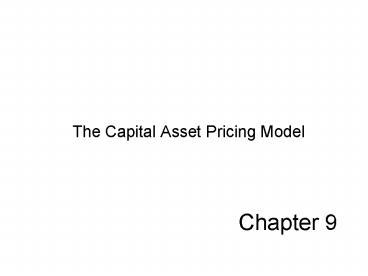The Capital Asset Pricing Model - PowerPoint PPT Presentation
1 / 22
Title:
The Capital Asset Pricing Model
Description:
Investments are limited to traded financial assets. No taxes and transaction costs. ... Sample Calculations for SML. Graph of Sample Calculations. E(r) Rx=13 ... – PowerPoint PPT presentation
Number of Views:47
Avg rating:3.0/5.0
Title: The Capital Asset Pricing Model
1
Chapter 9
- The Capital Asset Pricing Model
2
Capital Asset Pricing Model (CAPM)
- It is the equilibrium model that underlies all
modern financial theory. - Derived using principles of diversification with
simplified assumptions. - Markowitz, Sharpe, Lintner and Mossin are
researchers credited with its development.
3
Assumptions
- Individual investors are price takers.
- Single-period investment horizon.
- Investments are limited to traded financial
assets. - No taxes and transaction costs.
4
Assumptions (contd)
- Information is costless and available to all
investors. - Investors are rational mean-variance optimizers.
- There are homogeneous expectations.
5
Resulting Equilibrium Conditions
- All investors will hold the same portfolio for
risky assets market portfolio. - Market portfolio contains all securities and the
proportion of each security is its market value
as a percentage of total market value.
6
Resulting Equilibrium Conditions (contd)
- Risk premium on the the market depends on the
average risk aversion of all market participants. - Risk premium on an individual security is a
function of its covariance with the market.
7
Capital Market Line
E(r)
CML
M
E(rM)
rf
?
?m
8
Slope and Market Risk Premium
- M Market portfolio rf Risk free
rate E(rM) - rf Market risk premium E(rM) -
rf Market price of risk - Slope of the CAPM
?
M
9
Return and Risk For Individual Securities
- The risk premium on individual securities is a
function of the individual securitys
contribution to the risk of the market portfolio. - An individual securitys risk premium is a
function of the covariance of returns with the
assets that make up the market portfolio.
10
Security Market Line
E(r)
SML
E(rM)
rf
b
bM 1.0
11
SML Relationships
- ???????????????????? COV(ri,rm) / ?m2
- Slope SML E(rm) - rf
- market risk premium
- SML rf ?E(rm) - rf
- Betam Cov (ri,rm) / sm2
- sm2 / sm2 1
12
Sample Calculations for SML
- E(rm) - rf .08 rf .03
- ?x 1.25
- E(rx) .03 1.25(.08) .13 or 13
- ?y .6
- e(ry) .03 .6(.08) .078 or 7.8
13
Graph of Sample Calculations
E(r)
SML
Rx13
.08
Rm11
Ry7.8
3
b
1.0
1.25 bx
.6 by
14
Disequilibrium Example
E(r)
SML
15
Rm11
rf3
b
1.25
1.0
15
Disequilibrium Example (cont.)
- Suppose a security with a ? of 1.25 is offering
expected return of 15. - According to SML, it should be 13.
- Under-priced offering too high of a rate of
return for its level of risk.
16
Blacks Zero Beta Model
- Absence of a risk-free asset
- Combinations of portfolios on the efficient
frontier are efficient. - All frontier portfolios have companion portfolios
that are uncorrelated. - Returns on individual assets can be expressed as
linear combinations of efficient portfolios.
17
Blacks Zero Beta Model Formulation
18
Efficient Portfolios and Zero Companions
E(r)
Q
P
Erz (Q)
Z(Q)
Z(P)
Erz (P)
s
19
Zero Beta Market Model
CAPM with E(rz (m)) replacing rf
20
CAPM Liquidity
- Liquidity
- Illiquidity Premium
- Research supports a premium for illiquidity.
- Amihud and Mendelson
21
CAPM with a Liquidity Premium
f (ci) liquidity premium for security i f (ci)
increases at a decreasing rate
22
Liquidity and Average Returns
Average monthly return()
Bid-ask spread ()































